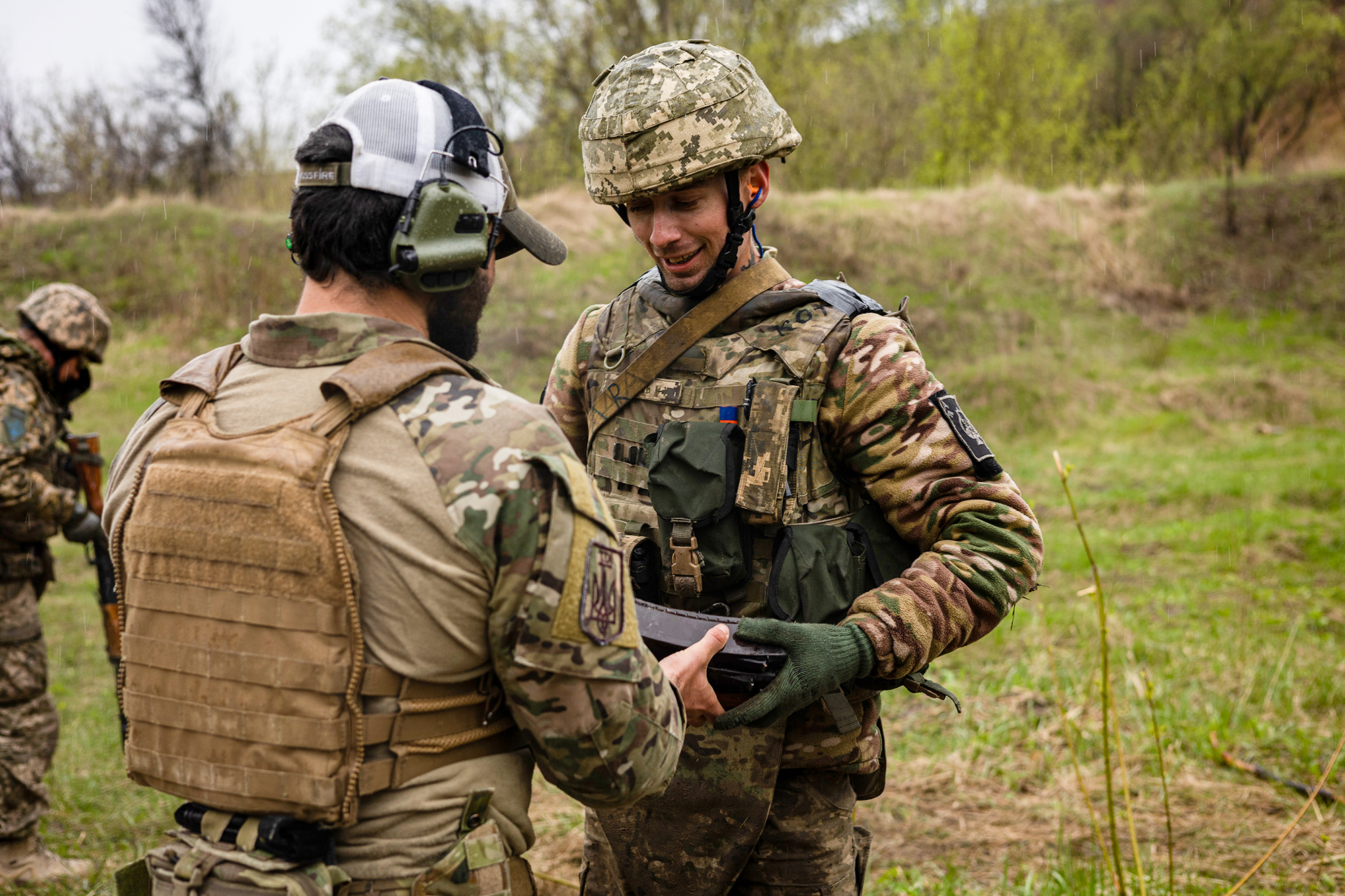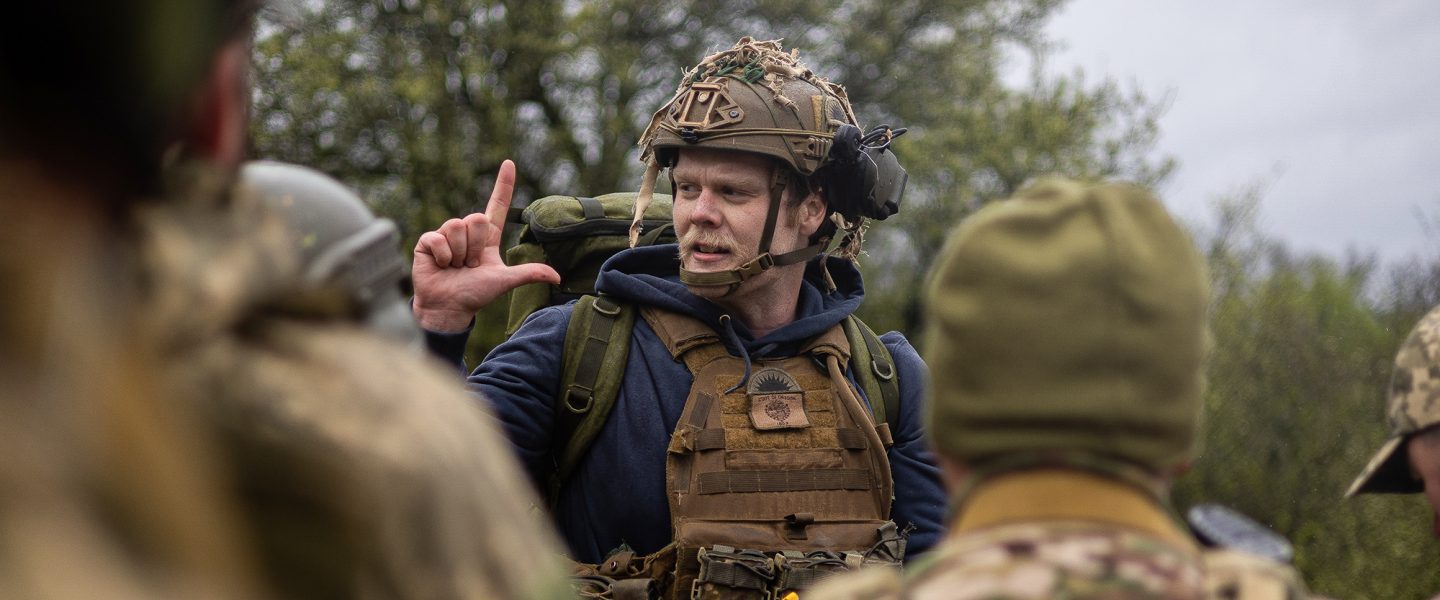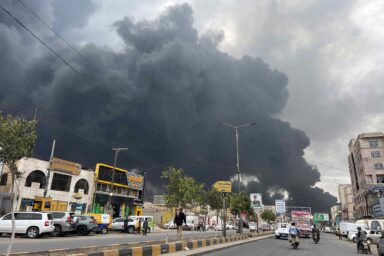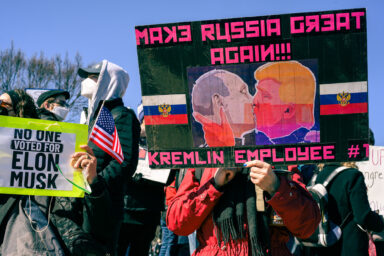Ahead of a highly anticipated Ukrainian counteroffensive, training led by Western instructors shows strong determination but major shortcomings in Ukrainian troops’ capabilities and discipline.
|
Listen To This Story
|
KHARKIV REGION, Ukraine — A cool trickle of rain nourished the earth one late April morning as the platoon of Ukrainian soldiers made their way to the edge of the top of a hill.
Not far away sat their objectives: a playground and a school. The soldiers needed to capture both, but not for an actual mission. They were participating in an exercise that was the culminating event of a two-week training course run by instructors who previously served in Western militaries.
The training aimed to sharpen the troops’ abilities ahead of a highly anticipated Ukrainian counteroffensive aimed at retaking territory captured by Russia. Several dozen troops from Ukraine’s Army and National Guard participated in the course, which was led by Trident Defense Initiative (TDI), a private training organization. Commanders had requested that their units participate in the course, which taught the troops NATO-style tactics related to combat operations, first aid and medical care, and more. For some of the Ukrainian troops, these were entirely new concepts.
As the platoon moved its way across the top of the hill, Cody, a former US Army soldier now working as a combat instructor with TDI, yelled at the lead Ukrainian soldier, Misha, to lie down. As he walked along the edge of the hill, Misha was skylining himself, a fatal mistake in which a person is clearly visible against the sky. In an actual combat operation, skylining would reveal Misha’s position and make him an easy target.
Misha lay down on the grass and put down his rifle. Cody crept up from behind and told Misha to pick it back up. Some of the troops regularly put their weapons aside, an improper practice by US military standards that Cody wanted to rectify. From this vantage point, Misha surveyed the land and considered how to proceed. Several hundred yards ahead sat the playground that he and the other soldiers needed to “capture” before continuing to their next target.

An hour earlier, Misha and several dozen other Ukrainian Army and National Guard troops had received a briefing that explained the training mission and the troops’ specific roles and responsibilities. An instructor who previously served in the Canadian military gave the brief in English. A Ukrainian interpreter then translated it for the troops, most of whom did not understand it. While the brief would have been familiar to NATO forces, it was confusing to the Ukrainians. For some of them, it was a new experience.
The purpose of the brief was to encourage the soldiers to think critically about their mission and their role in it. The instructors noted that the Ukrainian military retains Soviet characteristics of rigid top-down thinking and decision making that stifles troops’ ability to perform in combat. The TDI instructors hoped to change the way the Ukrainian military operates by teaching a NATO-style bottom-up approach that emphasizes critical thinking and decision-making among low-ranking troops.
“They’re going through an unprecedented change from the Soviet system to more of a NATO system,” said Blaze, an instructor who previously served in the Australian military.
Many of these troops had previously seen combat, but not all had received much formalized training. The instructors acknowledged that two weeks of training was just a drop in the bucket compared to Western forces who train continuously in such tactics throughout their military careers.

“The main thing I talked to them about at the start was that I wanted them to be … thinking soldier[s],” Blaze continued. “Ask [your commanders] questions, respectfully, of course. But I want you to be able to … think about stuff and ask questions for yourself.”
Later, as the Ukrainian troops advanced to the playground, Cody confided that he wasn’t a big fan of the brief. What he cared more about was seeing the soldiers properly executing combat movements like patrols and assaults.
”The main thing I want them to practice is room clearing,” Cody said, referring to a term for capturing rooms and buildings from enemy forces. Such skills would also be applicable to fighting in trenches, which most of the soldiers would likely be doing, he noted.
The training benefited all of the troops, but especially those who had not received adequate training after joining during rapid mobilization at the start of Russia’s full-scale invasion of Ukraine last February. One of the soldiers, Dmytro, said that when he joined a local defense unit at the start of the war he got a rifle and some basic instruction about how to establish defensive positions and shoot down helicopters. Other than that, Dmytro said he didn’t learn much. He and his comrades had spent their free time researching tactics online.
“Some of us were volunteers,” Dmytro said. “We basically didn’t have any time for training, for anything.”

At times, the instructors noticed the lack of formal training among some of the troops. Cody and other instructors constantly reminded some Ukrainian troops to adhere to weapon safety rules like keeping their fingers off the trigger of their rifle when they weren’t shooting. During target practice at a range one day, a couple of soldiers opted not to shoot, saying they were bored and uninterested in the training. One asked to be allowed to step away, saying that the smell of gunpowder had triggered memories of a friend killed in battle. In each instance, the instructors permitted the troops to walk away, noting that yelling or aggressively pushing back — as they might have in their own militaries — was not an efficient way to train the Ukrainians.
“Before the war, it was not an army,” said Viktor, a former soldier who rejoined the Ukrainian military last year at the start of the Russian invasion. “They didn’t teach us anything because there was no war.”
The soldiers had a motley assortment of body armor, clothing, and weapon accessories. Dmytro noted that a lot of gear is lost or damaged during operations, and some soldiers have to rely on donations or even their own money to acquire helmets, body armor, and other equipment.
Some of the Ukrainian troops displayed poor discipline at times. On the first day of the course, some of the soldiers arrived drunk, said Roger, an instructor who previously served in the French Foreign Legion. That day, the instructors canceled the training for the first time.
Roger said it was normal for one soldier to turn up intoxicated, but not “20 or 30 guys.”
During shooting drills one day, the soldiers at times ignored the instructors’ orders. When one switched his rifle to fully automatic and fired a volley of rounds into his target — a violation of the range safety rules — some of the soldiers near him laughed. One patted him on the head.
“Typically [the training is] pretty smooth,” said Cody. “This is a particularly difficult group to work with because they’re combat veterans and a lot of them just have no morale.”
More than a year of fighting had brought the troops close together, but it had also left many tired and disgruntled.
“Maybe 20 percent are ready to go back to fight,” said Viktor, one of the soldiers. “They are in good morale. They had a vacation before training. They had good training and they had enough time to rest.
“But it’s 20 percent,” he added.
Another soldier, Andriy, said that he had had only one break since the war began last February. That much-needed 10-day break had come just before the start of this training course.

By the end of the soldiers’ final training event, they had “captured” the playground and school from fictional Russian troops. The entire exercise took a few hours. It was chaotic and disorganized. The troops argued amongst each other and required continuous guidance from the instructors.
As messy as it was, however, the instructors thought that the troops had grasped many of the skills taught to them. They just needed more time to refine them.
“It looked like — at least with the [National Guard troops] that I was with — they have the right ideas,” said Blaze. “When they were microplanning their actual movements, they were good plans. It’s just that the execution is an issue.”
After the training’s completion, some of the troops headed for positions near the Russian border. They noted before departing that they expected to man trenches.
“It was pretty useful,” Dmytro said about the training. The medical and first aid training was especially helpful, he said. Some of his fellow soldiers learned how to use tourniquets, medical gear vital for stopping bleeding.
But he agreed with the instructors that two weeks of training was not enough.
“It’s the best we can do with the time that we got,” said Dan Ridley, president and founder of TDI. “But… there’s definitely a difference from when they come to when they leave.”
The day after the completion of the course, the soldiers hosted a barbecue. They laughed and joked around a large table as they ate meat and bread and drank vodka and compote. Viktor said that he was tired, but he was determined to keep fighting, even if the war continued for many years. Many of his fellow soldiers shared that motivation too.
“We are exhausted,” Viktor said, “but we want our territories back.”




